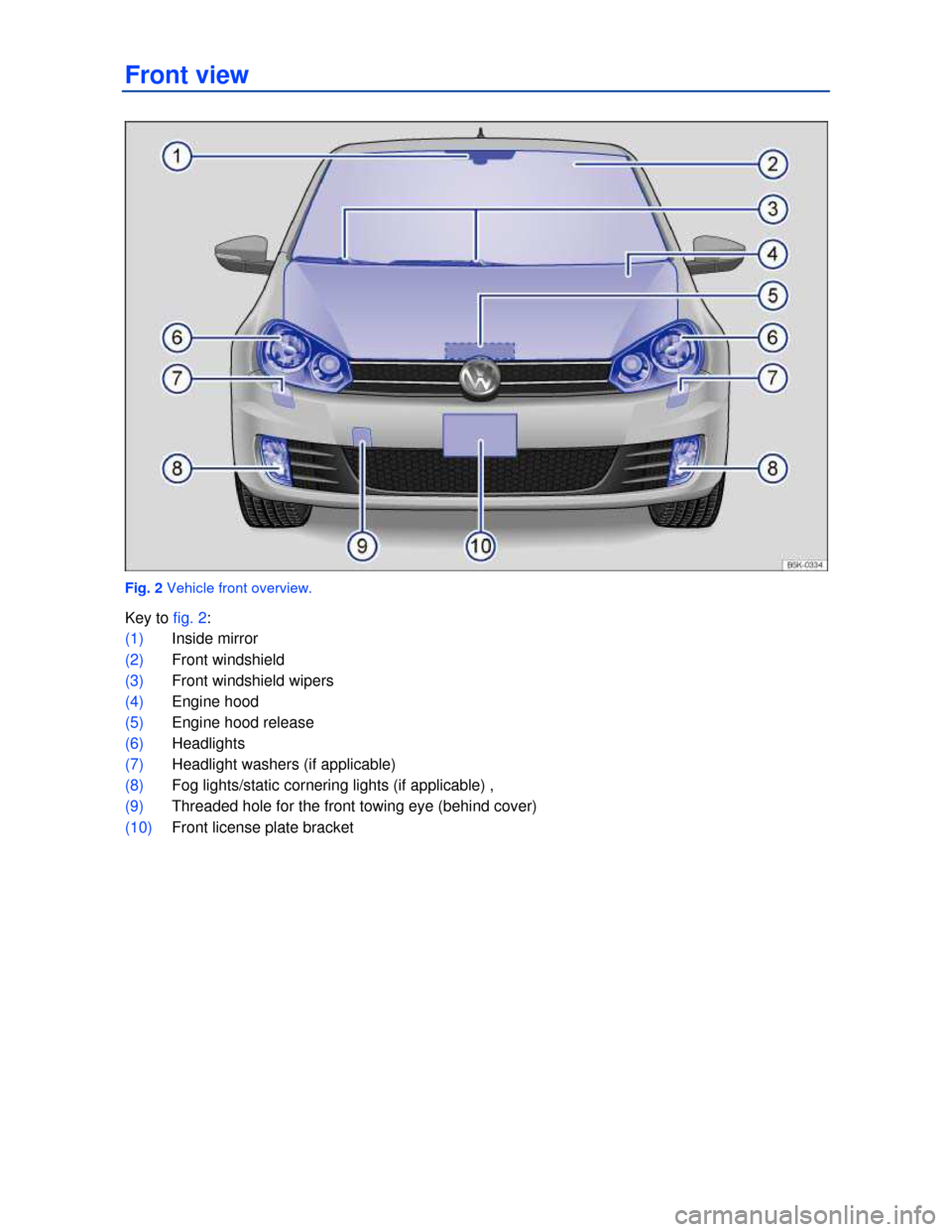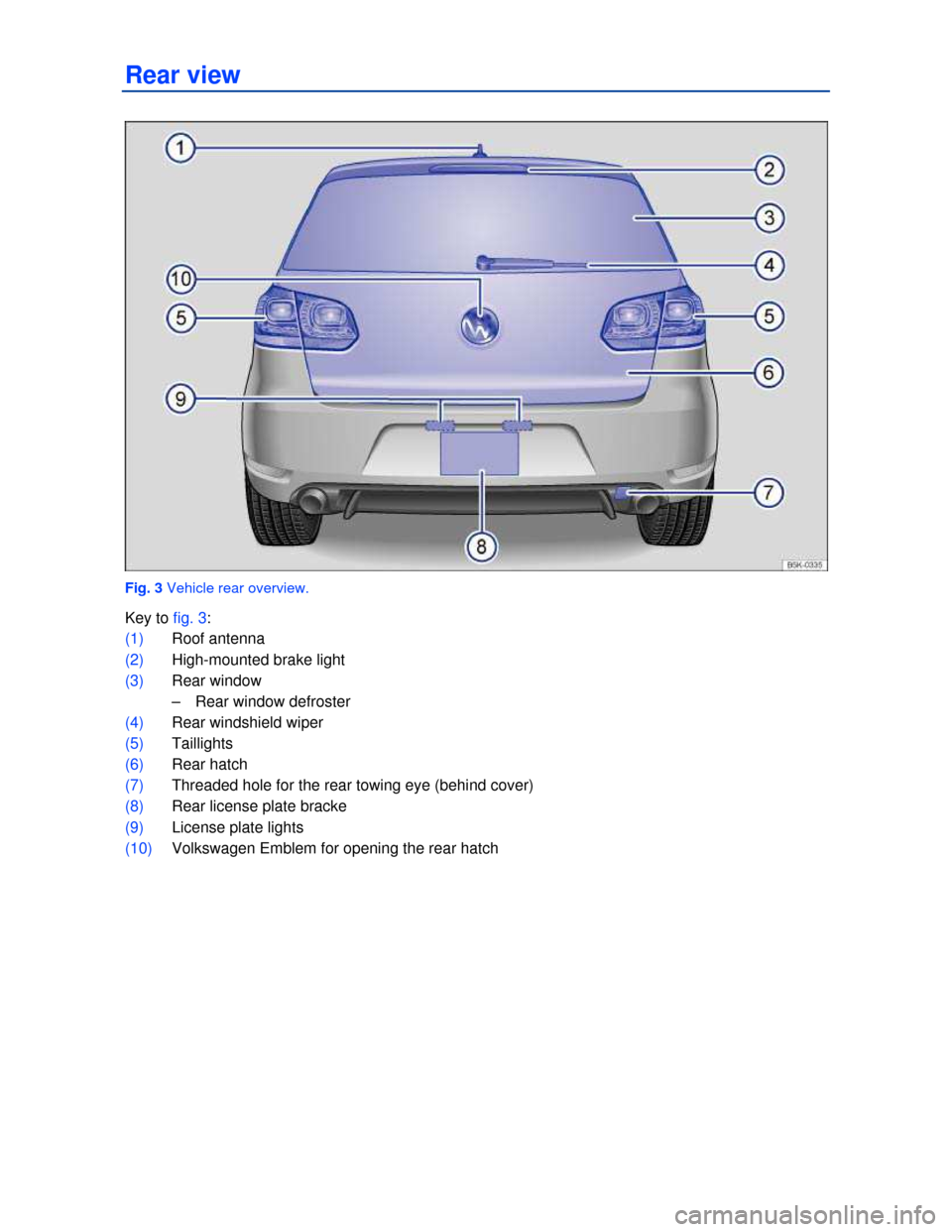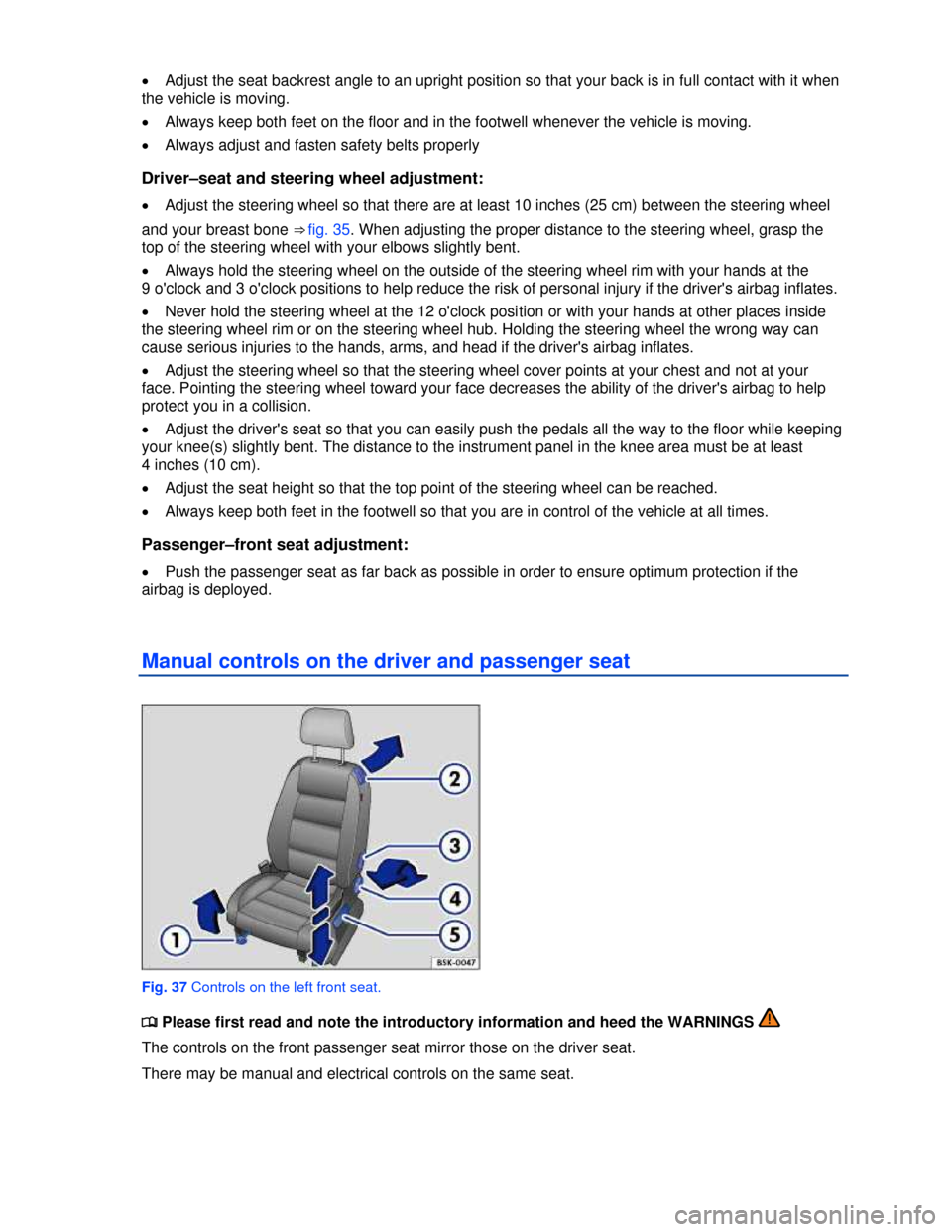2013 VOLKSWAGEN GOLF GTI tow
[x] Cancel search: towPage 2 of 319

Front view
Fig. 2 Vehicle front overview.
Key to fig. 2:
(1) Inside mirror
(2) Front windshield
(3) Front windshield wipers
(4) Engine hood
(5) Engine hood release
(6) Headlights
(7) Headlight washers (if applicable)
(8) Fog lights/static cornering lights (if applicable) ,
(9) Threaded hole for the front towing eye (behind cover)
(10) Front license plate bracket
Page 3 of 319

Rear view
Fig. 3 Vehicle rear overview.
Key to fig. 3:
(1) Roof antenna
(2) High-mounted brake light
(3) Rear window
– Rear window defroster
(4) Rear windshield wiper
(5) Taillights
(6) Rear hatch
(7) Threaded hole for the rear towing eye (behind cover)
(8) Rear license plate bracke
(9) License plate lights
(10) Volkswagen Emblem for opening the rear hatch
Page 28 of 319

¥ Properly fasten your safety belt before driving the vehicle and wear your safety belt properly at all
times while driving. Make sure that all passengers do the same
¥ Only transport as many passengers as there are seats and safety belts available.
¥ Never drive if your driving ability has been impaired, for example by medication, alcohol or illegal
drugs.
¥ Never let passengers or phone calls distract you while driving, and never take your attention off the
road while using vehicle software or adjusting vehicle equipment or accessories.
¥ Always adapt your speed and driving style to visibility, weather, road, and traffic conditions.
¥ Always obey traffic laws and speed limits.
¥ On long trips make frequent rest stops – at least once every 2 hours.
¥ Secure animals in the vehicle with a system that corresponds to weight and size.
WARNING
Always observe traffic rules and posted speed limits and use common sense. Your good
judgment can mean the difference between arriving safely at your destination and being seri-
ously injured in a crash or other kind of accident.
Regular service and maintenance of your vehicle is important both for operational and driving
safety and to help prolong your vehicle's service life. Always follow the scheduled maintenance inter-
vals in the ⇒ Booklet Warranty and Maintenance, especially for changing the brake fluid. Hard use,
frequent stop-and-go driving, driving in very dusty areas, trailer towing, and other factors may make it
necessary to have the vehicle serviced more frequently. Ask an authorized Volkswagen dealer or an
authorized Volkswagen Service Facility for more information.
Driving in other countries
�
Page 38 of 319

Power locking and closing system
Introduction
In this section you’ll find information about:
Description of the power locking system
Unlocking or locking the vehicle from the outside
Unlocking or locking the vehicle from the inside
Unlocking or locking vehicles with Keyless Access
Anti-theft alarm system
The power locking system works properly only when all doors and the rear hatch are completely
closed. When the driver door is open, the vehicle cannot be locked with the remote control vehicle key.
For vehicles equipped with the Keyless Access locking and starting system, the vehicle can be locked
only if the ignition is switched off and the driver door is closed.
Leaving the vehicle unlocked for longer periods of non-use (for example, in your garage) can cause
the vehicle battery to drain so that the engine can no longer be started.
More information:
�x Exterior views
�x Volkswagen Information System
�x Vehicle key set
�x Doors
�x Rear hatch
�x Power windows
�x Power sunroof
�x Trailer towing
�x Emergency closing and opening
WARNING
Improper use of power locks can result in serious personal injury.
�x The power locking button locks all doors. Locking the doors from the inside can help
prevent unintended door opening during a collision and can also prevent unwanted entry
from the outside. Locked doors can, however, delay assistance to vehicle occupants and
rescue from the outside in an accident or other emergency.
�x Never leave children or anyone who cannot help themselves behind in the vehicle. All
doors can be locked from the inside with the power lock button. This could leave people
trapped in the vehicle in an emergency. Depending on the time of year, people trapped in the
vehicle can be exposed to very high or very low temperatures.
�x A closed vehicle can become very hot or very cold, depending on the season. Particularly
in the summer, heat build-up in the passenger and luggage compartment of a parked vehicle
can result in temperatures in the vehicle that are much higher than the outside temperatures.
Temperatures can quickly reach levels that can cause unconsciousness and death,
particularly to small children.
�x Never allow passengers to remain in a locked vehicle. In an emergency any person still
inside the vehicle might not be able to get out.
Page 59 of 319

WARNING
Always adjust seat, safety belts, and head restraints properly before driving and make sure
that all passengers are properly restrained.
�x Push the passenger seat as far back as possible. Always be sure that there are at least
10 inches (25 cm) between the front passenger's breastbone and the instrument panel.
�x Always adjust the driver's seat and the steering wheel so that there are at least 10 inches
(25 cm) between your breastbone and the steering wheel.
�x Adjust the driver's seat so that you can easily push the pedals all the way to the floor
while keeping your knee(s) slightly bent. The distance to the instrument panel in the knee
area must be at least 4 inches (10 cm).
�x If these requirements cannot be met for physical reasons, contact an authorized
Volkswagen dealer or an authorized Volkswagen Service Facility to see whether adaptive
equipment is available.
�x Always hold the steering wheel on the outside of the steering wheel rim with your hands
at the 9 o'clock and 3 o'clock positions to help reduce the risk of personal injury if the
driver's airbag inflates.
�x Never hold the steering wheel at the 12 o'clock position or with your hands at other places
inside the steering wheel rim or on the steering wheel hub. Holding the steering wheel the
wrong way can cause serious injuries to the hands, arms, and head if the driver's airbag
inflates.
�x Pointing the steering wheel toward your face decreases the ability of the driver's airbag to
help protect you in a collision.
�x Never drive with backrests reclined or tilted back farther than necessary to drive
comfortably. The farther back the backrests are tilted, the greater the risk of injury caused by
incorrect positioning of the safety belts and improper seating position.
�x Never drive with the front seat passenger backrest tilted forward. If the front airbag
deploys, the front backrest can be forced backward and injure passengers on the rear seat.
�x Sit as far back as possible from the steering wheel and the instrument panel.
�x Always sit upright with your back against the backrest with the front seats properly
adjusted. Never lean against or place any part of your body too close to the area where the
airbags are located.
�x Rear seat passengers who are not properly seated and restrained are more likely to be
seriously injured in a crash.
WARNING
Improper adjustment of the seats can cause accidents and severe injuries.
�x Never adjust the seats while the vehicle is moving. Your seat may move unexpectedly and
you could lose control of the vehicle. In addition, you will not be in the correct seating
position while adjusting the seats.
�x Adjust the front seat height, angle and longitudinal direction only if the seat adjustment
area is clear.
�x The adjustment of the front seats must not be restricted by things in the footwell in front
or behind the seats.
Examples of improper seating positions
�
Page 62 of 319

�x Adjust the seat backrest angle to an upright position so that your back is in full contact with it when
the vehicle is moving.
�x Always keep both feet on the floor and in the footwell whenever the vehicle is moving.
�x Always adjust and fasten safety belts properly
Driver–seat and steering wheel adjustment:
�x Adjust the steering wheel so that there are at least 10 inches (25 cm) between the steering wheel
and your breast bone ⇒ fig. 35. When adjusting the proper distance to the steering wheel, grasp the
top of the steering wheel with your elbows slightly bent.
�x Always hold the steering wheel on the outside of the steering wheel rim with your hands at the
9 o'clock and 3 o'clock positions to help reduce the risk of personal injury if the driver's airbag inflates.
�x Never hold the steering wheel at the 12 o'clock position or with your hands at other places inside
the steering wheel rim or on the steering wheel hub. Holding the steering wheel the wrong way can
cause serious injuries to the hands, arms, and head if the driver's airbag inflates.
�x Adjust the steering wheel so that the steering wheel cover points at your chest and not at your
face. Pointing the steering wheel toward your face decreases the ability of the driver's airbag to help
protect you in a collision.
�x Adjust the driver's seat so that you can easily push the pedals all the way to the floor while keeping
your knee(s) slightly bent. The distance to the instrument panel in the knee area must be at least
4 inches (10 cm).
�x Adjust the seat height so that the top point of the steering wheel can be reached.
�x Always keep both feet in the footwell so that you are in control of the vehicle at all times.
Passenger–front seat adjustment:
�x Push the passenger seat as far back as possible in order to ensure optimum protection if the
airbag is deployed.
Manual controls on the driver and passenger seat
Fig. 37 Controls on the left front seat.
�
Page 67 of 319

Removing the front head restraints
�x Sit in the back seat behind the head restraint you want to remove. Pull the head restraint all the
way up ⇒ in Adjusting the front and rear head restraints. Recline the backrest with the head
restraint so that there is enough overhead clearance to remove it.
�x Slide a flat object, such as a plastic credit card, underneath the right side of the cap on the right-
hand seat guide rod ⇒ fig. 41 (1) to unlock the head restraint.
�x Push the flat object (plastic card) in against the guide rod to depress a release button located
under the cap (not visible).
�x Use one hand to hold the release button in with the flat object. With your other hand, lift the same
guide rod slightly to expose a notch in the rod at the bottom (can be seen and felt with fingers). The
right-hand guide rod is now released.
�x To release the left-hand guide rod, press button (2) in (towards guide rod) and hold.
�x Pull the head restraint out completely while holding button (2).
Installing the front head restraints
�x Position head restraint properly over the head restraint guides of the respective seat backrest and
insert the head restraint into the guides.
�x Push the head restraint down while pressing button (2).
�x Move the seat backrest into an upright position.
�x Adjust the head restraint according to the occupant's size .
Removing the rear head restraint
�x Unlock the backrest of the rear seat bench and fold it forward
�x Pull the head restraint all the way up ⇒ .
�x If necessary, press the flat blade of the screwdriver from the vehicle tool kit into the slit of the trim
cap ⇒ fig. 42 (1) in the direction of the arrow and hold it in this position.
�x At the same time press button (2) while a second person pulls out the head restraint completely.
�x Fold the backrest of the rear seat bench back so that it locks securely.
Reinstalling the rear head restraint
�x Unlock the backrest of the rear seat bench and fold it forward
�x Position head restraint properly over the head restraint guides of the respective seat backrest and
insert the head restraint into the guides.
�x Push the head restraint down while pressing button (2).
�x Fold the backrest of the rear seat bench back so that it locks securely.
�x Adjust the head restraint according to the occupant's size
WARNING
Driving without head restraints or with improperly adjusted head restraints increases the risk
of serious injuries in a collision.
�x Always drive with the head restraints in place and properly adjusted to help minimize the
risk of neck injury in crash.
�x Always reinstall head restraints as soon as possible so that vehicle occupants are
properly protected.
Page 75 of 319

WARNING
Not wearing a safety belt or wearing an improperly positioned safety belt increases the risk of
severe personal injury or death. Safety belts offer optimum protection only when they are
used properly.
�x Properly worn safety belts are the single most effective means of reducing the risk of
serious injury and death in a collision or other accident. For this reason, always wear your
safety belt properly and make sure all passengers wear their safety belts properly as well
whenever the vehicle is moving.
�x The driver must always make sure that every person in the vehicle is properly seated on a
seat of his or her own, properly fastens the safety belts belonging to that seat before the
vehicle starts to move, and keeps the belts properly fastened while riding in the vehicle. This
applies even when just driving around town. Therefore, always wear your safety belts and
make sure that everybody in your vehicle is properly restrained.
�x Always secure children in the vehicle with a restraint system appropriate for their age,
weight and height
�x Always fasten safety belts correctly before driving off and make sure that all passengers
are properly restrained.
�x Never attach the safety belt to the buckle of another seat. Attaching the safety belt to the
wrong buckle will reduce safety belt effectiveness and can cause serious personal injury.
�x Never let any objects or liquids get into the safety belt latch and prevent it from working
properly.
�x Never remove a safety belt while the vehicle is moving. Doing so will increase your risk of
being injured or killed.
�x Never strap more than one person, including small children, into any single safety belt.
�x Never let children or babies ride sitting on your lap, and never place a safety belt over a
child sitting on your lap.
�x Never wear belts over rigid or breakable objects in or on your clothing, such as
eyeglasses, pens, keys, etc., as these may cause injury.
�x Several layers of heavy clothing (such as a coat worn over top of a sports jacket) may
interfere with proper positioning of the safety belt and reduce the overall effectiveness of the
system.
�x Never use comfort clips or devices that create slack in the shoulder belt. However, special
clips may be required for the correct use of some child restraint systems.
�x Safety belts offer optimum protection only when the seat backrest is upright and belts are
correctly positioned on the body.